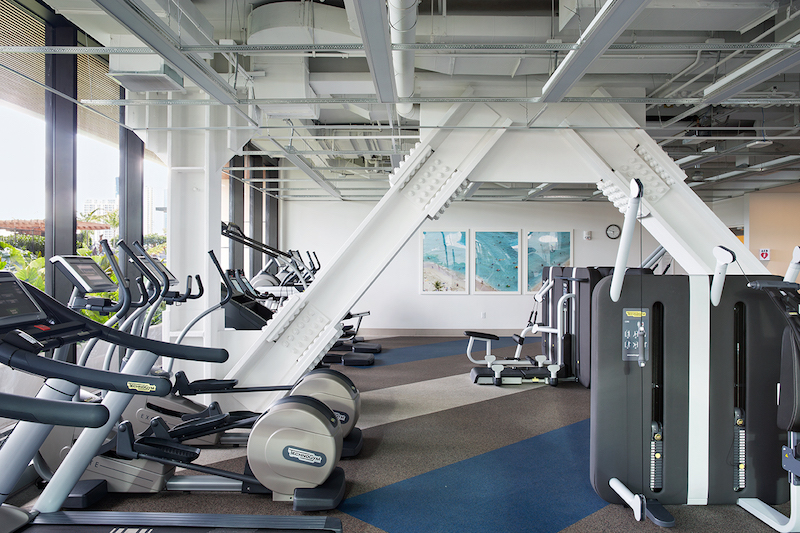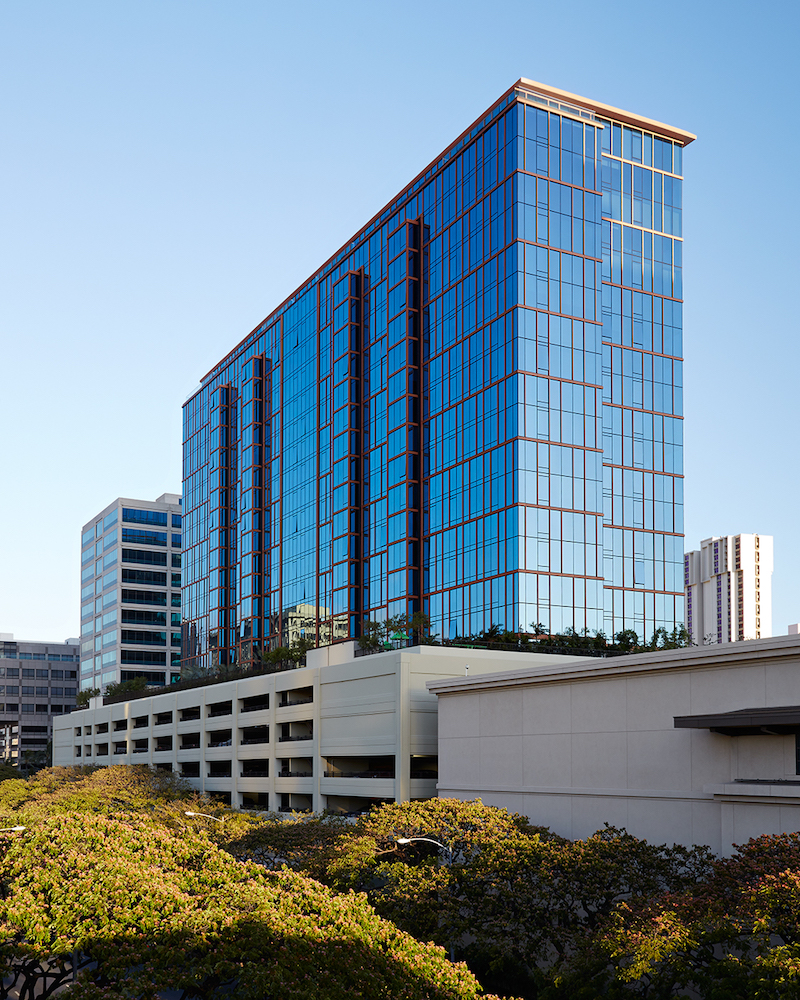The structural challenges of building an 18-story tower atop an existing parking garage inspired an innovative design solution for the One Ala Moana condominiums in Honolulu.
About 10 years ago, General Growth Properties undertook the expansion of its Ala Moana Center, Hawaii’s largest mall. The retail market looked strong, and the developer was even able to add the Aloha State’s first Nordstrom department store to the shopping center. An adjacent five-story parking structure was completed in 2008, with the idea of building a luxury residential tower atop the garage. But the Great Recession—and General Growth Properties’ subsequent declaration of bankruptcy—put the kibosh on those plans.
In 2010 Howard Hughes Corporation acquired the rights to develop the tower as part of General Growth Properties’ bankruptcy reorganization. Hughes partnered with local developers The MacNaughton Group and Kobayashi Group on the project. Architecture firm Solomon Cordwell Buenz won the design competition to build the tower.
SCB’s foremost technical obstacle involved developing an efficient structural transfer system to address the misalignment between the column grids of the garage and those of the new tower. SCB and Magnusson Klemencic Associates, a structural engineering firm that had worked on the original parking garage, came up with a fresh approach to the problem. They proposed installing a series of 13-foot-tall steel trusses, each weighing more than 50 tons, to transfer the tower’s loads to grade.
“Unlike the original tower design, which proposed a large concrete transfer structure between the garage and residential tower, we wanted to make the transfer structure as light as possible so we could create habitable space along that structure,” says SCB’s Benjamin Wrigley, AIA, Senior Designer and Associate Principal.
The SCB/MKA design team reworked the concept for the structural system, using 50-ton steel trusses, 13 feet in height, to support the tower. This allowed them to design a wider building than originally planned and to create a format with two elevator cores. It was, says SCB’s Chris Pemberton, “a pleasant surprise.” Photo: Mariko Reed/SCB.
This system not only provided planning flexibility in column locations to make the most efficient use of residential unit layouts; it also enabled the transfer level on the garage roof to become an active floor of the new building.
“We worked closely with SCB to help them configure the trusses on the transfer level to accommodate functional spaces between them,” says Peter Somers, PE, SE, a Principal in MKA’s Seattle office. The transfer level houses the building’s main lobby and amenities spaces, including a fitness center, media center, library, and wine bar.
The reconfigured design also made possible an amenities deck with a pool, a children’s play area, and a landscaped running track, all supported by long-span steel framing on the 60-foot parking column grid. Instead of these amenities taking up space higher up in the building, the new structural solution made it possible to add another floor of residential units. Says Wrigley, “That was obviously very appealing to the developers.”
Except in the fitness center and a couple of other spaces where they are intentionally exposed for aesthetic purposes, the steel trusses are integrated into the building walls, rendering them essentially invisible.
“You can walk through the entire sequence of trusses and not really know they are there,” says Wrigley. “That space became very dramatic.” So dramatic, in fact, that the owners, who are serious art collectors, created a gallery space to display their art collection.
Additional design opportunities emerged from a technical analysis of the parking structure to reassess its true load capacity.
“We tested the foundations, including the soils and the hardness of the concrete, and found that the structure had a higher bearing capacity than the original design had allowed for,” says SCB Principal Chris Pemberton, AIA, who directs the firm’s San Francisco office. “That meant we could design a wider building and introduce some indoor-outdoor spaces and lanais off the residential units that we hadn’t anticipated as we started the project.” It was, he says, “a pleasant surprise.”
 Photo: Mariko Reed/SCB.
Photo: Mariko Reed/SCB.
SHAPING THE EXPERIENCE
The arrival experience at One Ala Moana is luxurious. An express elevator in the garage transports residents to the lobby, where it splits into two separate elevator cores, similar to a sky lobby in a high-end hotel.
“We took a long building—almost the length of a football field—and divided it into two elevator cores, north and south,” says Pemberton. “That allowed us to break the floor plan down and have the majority of the units face the ocean, which created a lot of value for the developers.”
The 205 residential units sold out within a few days after hitting the market in late 2014. “The key to the success of the project was that we were able to make it invisible that we were building on top of a garage,” says Pemberton.
SCB is making use of the knowledge it gained from the One Ala Moana experience. “The heightened level of luxury presented by a twin-core residential building is something we applied to the next project we did in Honolulu, with great success,” says Pemberton.
Constructing over existing structures is becoming increasingly common, particularly in dense urban areas, says Shelley Clark, PE, SE, Senior Principal in MKA’s Seattle office. “Any time you add to an existing building, you try to minimize whatever upgrades you need to do to make it happen,” she says.
“On this project, we were able to adaptively reuse the existing parking garage framing and integrate the expansion capacities of the existing columns, walls, and foundations,” says Clark. “But there’s no stock solution. You have to figure out strategies to minimize construction costs and how much upgrading and rebuilding is required.”
Related Stories
| Jan 4, 2011
Grubb & Ellis predicts commercial real estate recovery
Grubb & Ellis Company, a leading real estate services and investment firm, released its 2011 Real Estate Forecast, which foresees the start of a slow recovery in the leasing market for all property types in the coming year.
| Dec 17, 2010
Condominium and retail building offers luxury and elegance
The 58-story Austonian in Austin, Texas, is the tallest residential building in the western U.S. Benchmark Development, along with Ziegler Cooper Architects and Balfour Beatty (GC), created the 850,000-sf tower with 178 residences, retail space, a 6,000-sf fitness center, and a 10th-floor outdoor area with a 75-foot saltwater lap pool and spa, private cabanas, outdoor kitchens, and pet exercise and grooming areas.
| Dec 17, 2010
Luxury condos built for privacy
A new luxury condominium tower in Los Angeles, The Carlyle has 24 floors with 78 units. Each of the four units on each floor has a private elevator foyer. The top three floors house six 5,000-sf penthouses that offer residents both indoor and outdoor living space. KMD Architects designed the 310,000-sf structure, and Elad Properties was project developer.
| Dec 17, 2010
Vietnam business center will combine office and residential space
The 300,000-sm VietinBank Business Center in Hanoi, Vietnam, designed by Foster + Partners, will have two commercial towers: the first, a 68-story, 362-meter office tower for the international headquarters of VietinBank; the second, a five-star hotel, spa, and serviced apartments. A seven-story podium with conference facilities, retail space, restaurants, and rooftop garden will connect the two towers. Eco-friendly features include using recycled heat from the center’s power plant to provide hot water, and installing water features and plants to improve indoor air quality. Turner Construction Co. is the general contractor.
| Dec 17, 2010
Toronto church converted for condos and shopping
Reserve Properties is transforming a 20th-century church into Bellefair Kew Beach Residences, a residential/retail complex in The Beach neighborhood of Toronto. Local architecture firm RAWdesign adapted the late Gothic-style church into a five-story condominium with 23 one- and two-bedroom units, including two-story penthouse suites. Six three-story townhouses also will be incorporated. The project will afford residents views of nearby Kew Gardens and Lake Ontario. One façade of the church was updated for retail shops.
| Dec 7, 2010
Prospects for multifamily sector improve greatly
The multifamily sector is showing signs of a real recovery, with nearly 22,000 new apartment units delivered to the market. Net absorption in the third quarter surged by 94,000 units, dropping the national vacancy rate from 7.8% to 7.1%, one of the largest quarterly drops on record, and rents increased for the second quarter in a row.
| Nov 3, 2010
Senior housing will be affordable, sustainable
Horizons at Morgan Hill, a 49-unit affordable senior housing community in Morgan Hill, Calif., was designed by KTGY Group and developed by Urban Housing Communities. The $21.2 million, three-story building will offer 36 one-bed/bath units (773 sf) and 13 two-bed/bath units (1,025 sf) on a 2.6-acre site.
| Nov 3, 2010
Rotating atriums give Riyadh’s first Hilton an unusual twist
Goettsch Partners, in collaboration with Omrania & Associates (architect of record) and David Wrenn Interiors (interior designer), is serving as design architect for the five-star, 900-key Hilton Riyadh.
| Nov 1, 2010
Sustainable, mixed-income housing to revitalize community
The $41 million Arlington Grove mixed-use development in St. Louis is viewed as a major step in revitalizing the community. Developed by McCormack Baron Salazar with KAI Design & Build (architect, MEP, GC), the project will add 112 new and renovated mixed-income rental units (market rate, low-income, and public housing) totaling 162,000 sf, plus 5,000 sf of commercial/retail space.
| Nov 1, 2010
Vancouver’s former Olympic Village shoots for Gold
The first tenants of the Millennium Water development in Vancouver, B.C., were Olympic athletes competing in the 2010 Winter Games. Now the former Olympic Village, located on a 17-acre brownfield site, is being transformed into a residential neighborhood targeting LEED ND Gold. The buildings are expected to consume 30-70% less energy than comparable structures.















